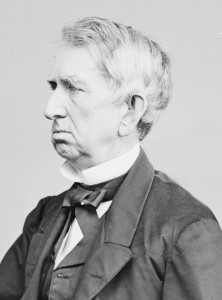William H. Seward, a Republican U.S. senator from New York, was hitting the campaign trail hard during the week before the presidential election of 1860. On October 30th he spoke before 15,000 people in Lyons, New York, a small town in Wayne County. The next day Seward spoke to another huge gathering (between 15,000 and 20,000 people) in Seneca Falls, New York. During his hour and a half speech he gave an overview of the slavery issue. Apparently there were too many Little Giants in Seneca County because toward the end of his speech Seward leaned on the audience to forgo its Democrat party tendencies as he ridiculed the split between the the Douglas and Breckinridge factions: “Where is your Democratic Party now? You had one a year ago, and then six months ago you had two.” [Loud cheers and laughter.] (The New-York Times. November 2, 1860)
On November 2nd Seward spoke at a huge event at the Palace Garden in New York City. There were so many people at the event that three stands were set up outside the main hall. Various substitute speakers spoke at these stands. Here’s an excerpt from Seward’s address from The New-York Times. November 3, 1860:
Then the Slave States, retaining their slave labor,
proceeded to build up a great interest on the growth
of cotton, and when they had grown cotton, and
made it a great material interest in the country, they
then fell down before it, and did homage to it. I do
not say they paid worship to it, but they anointed it
King [laughter,] and they pronounced allegiance to
cotton to be a political duty. Did anybody interfere
with that homage? Did anybody complain of it?
Never! They were men at liberty, like ourselves,
to raise a commercial and political king—a social
king—within the Republic. But they set up the
throne in our midst, and said that we must bend and
bow before it too. [Laughter.] But from that requirement we have modestly but firmly—not always very firmly, neither [laughter]—but with tolerable persistence, declined to comply. Now they find that their system does not build up
great States like New-York, but on the other
and that the six States which pursued
their system have remained stationary, or relatively
so. The greatest and finest site for commerce on this
continent is New-Orleans, and in early life I made a
pilgrimage there to see whether it was not true that
New-Orleans was to supercede and supplant New-
York, the capital of my native State, as the seat of
commerce on this continent . I found that whereas
there were some ten times the population in New-
York that there was in New-Orleans, that it was in-
creasing in a ratio of such magnitude that
when New-Orleans would have a quarter
of a million, New-York would have a
million and a half. Shall I tell you the
reason? I found it in the fact that when I went out
in the night in the City of New-York, I saw the cobbler’s light
twinkling in his window in the gray of the
morning or late at night. I saw everything made, as
well as sold, in New-York; but when I came to the
city of New-Orleans I found there that everything
was sold and nothing was made. …
Fellow-citizens, this is not a reproach. It is not spoken reproachfully, it would ill become me to so speak it.But it is their system. They employ slaves, and in New-York—I was going to say that we “employ,” but I think I will reverse it and say that freemen employ their masters, [cheers,] the manufacturers. This is but an illustration.
Notes
- Seward stresses the great reliance the South had on agriculture in general and “King Cotton” in particular
- He plays the politician by flattering his audience of freemen – they employ the manufacturers
- And he plays to the pride of the New York City residents: I was surprised that Seward, a U.S. senator from New York and one-time governor, would declare that New York City was the state capital. Albany is the capital. In some ways, it does seem that New York is the de facto state capital. For example, this past Tuesday Andrew Cuomo celebrated his election as governor of the state in New York City.
- Civil War Home has an interesting article that might indicate when Seward was first introduced to King Cotton.
- For a brief history and picture of New York’s old Palace Garden check out Vintage World
- The complete Seward speech in Seneca Falls is reproduced at The New York Times Archive
- I just found another reference to the “Little Giants” during the 1860 campaign at The New York Times Archive. On September 20 the Little Giants in Buffalo were part of the welcoming committee when Douglas arrived from Niagara Falls. By the way, it’s interesting to me how short a period of time the Erie Canal was dominant. The locks of Lockport were a major engineering feat during the construction of the original Erie Canal (completed in 1825). According to The Times 2,000 people from Lockport arrived at Douglas’ Buffalo event by “special train”.
As always, I look forward to your comments. Thanks!


Pingback: Diogenes Campaigns for Lincoln? | Blue Gray Review